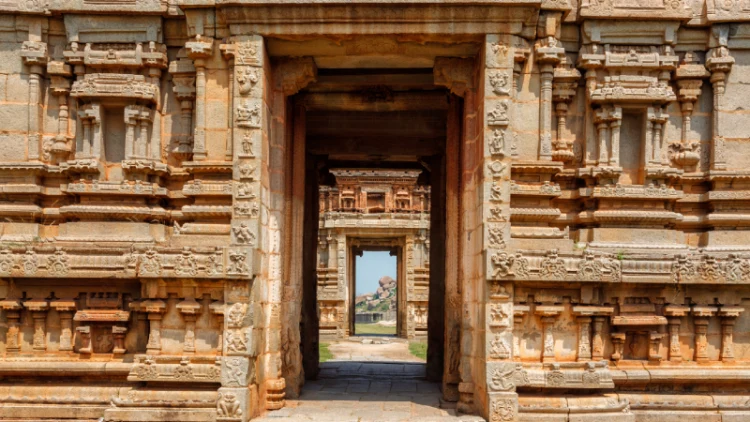Karnataka is home to some of India’s most iconic UNESCO World Heritage Sites, and among them, Hampi and Pattadakal stand out for their historical and architectural significance. While Hampi is famous for its grand Vijayanagara Empire ruins, Pattadakal is renowned for its exquisite Chalukyan temples. But how do these two destinations compare, and which one should you visit? In this guide, we’ll explore the key differences and similarities between Hampi and Pattadakal to help you decide.
Overview of Hampi and Pattadakal
Hampi
- Location: Bellary District, Karnataka.
- Historical Significance: Capital of the Vijayanagara Empire (14th–16th century).
- Key Attractions: Virupaksha Temple, Vittala Temple, Lotus Mahal, Hampi Bazaar, and more.
- UNESCO World Heritage Site: Yes (1986).
Pattadakal
- Location: Bagalkot District, Karnataka.
- Historical Significance: A group of 8th-century temples built by the Chalukya Dynasty.
- Key Attractions: Virupaksha Temple, Mallikarjuna Temple, Sangameshwara Temple, and more.
- UNESCO World Heritage Site: Yes (1987).
Comparing Hampi and Pattadakal
1. Historical Significance
- Hampi: Hampi was the capital of the Vijayanagara Empire, one of the most powerful empires in Indian history. Its ruins reflect the grandeur and prosperity of the empire.
- Pattadakal: Pattadakal served as a ceremonial center for the Chalukya Dynasty and is known for its group of temples that showcase a blend of North Indian (Nagara) and South Indian (Dravidian) architectural styles.
Verdict: Both destinations are historically significant, but Hampi’s scale and grandeur give it an edge.
2. Architecture and Art
- Hampi:
- Features a blend of Dravidian and Indo-Islamic architectural styles.
- Known for its massive temples, intricate carvings, and monolithic statues.
- Highlights include the stone chariot at Vittala Temple and the musical pillars.
- Pattadakal:
- Famous for its group of temples that showcase a fusion of Nagara and Dravidian styles.
- The temples are adorned with intricate carvings of deities, mythological scenes, and floral patterns.
- The Virupaksha Temple in Pattadakal is a masterpiece of Chalukyan architecture.
Verdict: Hampi’s architecture is more diverse and grand, while Pattadakal’s temples are unique for their architectural fusion.
3. Natural Beauty
- Hampi:
- Surrounded by rocky hills, lush paddy fields, and the Tungabhadra River.
- Offers stunning sunrise and sunset views from Matanga Hill and Hemakuta Hill.
- Pattadakal:
- Located on the banks of the Malaprabha River, with a serene and picturesque setting.
- The surrounding landscape is less dramatic compared to Hampi but still beautiful.
Verdict: Hampi’s landscape is more dramatic and varied, making it a better choice for nature lovers.
4. Cultural Experiences
- Hampi:
- Vibrant local markets like Hampi Bazaar offer a glimpse into traditional crafts and cuisine.
- Festivals like Hampi Utsav celebrate the region’s cultural heritage.
- Opportunities to interact with local artisans and learn about traditional crafts.
- Pattadakal:
- A quieter, more laid-back destination with fewer tourists.
- Local culture revolves around temple rituals and traditional practices.
- Nearby villages like Aihole and Badami offer additional cultural insights.
Verdict: Hampi offers a more vibrant and immersive cultural experience, while Pattadakal is ideal for those seeking tranquility.
5. Accessibility and Infrastructure
- Hampi:
- Well-connected by road and rail. The nearest railway station is Hospet Junction (13 km).
- Accommodation options range from budget hostels to mid-range hotels.
- More tourist-friendly with better infrastructure.
- Pattadakal:
- Accessible by road. The nearest railway station is Badami Railway Station (22 km).
- Limited accommodation options, mostly budget and mid-range hotels.
- Quieter and less crowded compared to Hampi.
Verdict: Hampi is more accessible and tourist-friendly, while Pattadakal is perfect for offbeat travelers.
6. Crowd and Atmosphere
- Hampi:
- A popular tourist destination, especially during peak seasons.
- Lively and bustling atmosphere, especially in Hampi Bazaar.
- Pattadakal:
- Less crowded and more peaceful.
- Ideal for those seeking a quiet and reflective experience.
Verdict: Hampi is livelier, while Pattadakal offers a more serene experience.
Which Destination is Better?
Choose Hampi If…
- You love exploring grand historical ruins and temples.
- You enjoy vibrant markets and cultural experiences.
- You’re an adventure enthusiast looking for activities like rock climbing and cycling.
- You prefer a destination with better infrastructure and more accommodation options.
Choose Pattadakal If…
- You’re interested in early temple architecture and a blend of Nagara and Dravidian styles.
- You prefer a quieter, offbeat destination with fewer crowds.
- You enjoy serene landscapes and peaceful activities like temple exploration.
- You want to explore nearby heritage sites like Aihole and Badami.
Suggested Itinerary for Combining Hampi and Pattadakal
If you can’t decide, why not visit both? Here’s a suggested 5-day itinerary:
Day 1–3: Hampi
- Explore the Virupaksha Temple, Vittala Temple, and Royal Enclosure.
- Enjoy a coracle ride on the Tungabhadra River.
- Watch the sunset from Matanga Hill.
Day 4–5: Pattadakal
- Visit the group of temples in Pattadakal, including the Virupaksha Temple and Mallikarjuna Temple.
- Explore nearby Aihole and Badami for additional historical insights.
Final Thoughts: Hampi or Pattadakal?
Both Hampi and Pattadakal are incredible UNESCO World Heritage Sites, each offering a unique experience. Hampi is perfect for those who love grand architecture, vibrant culture, and adventure, while Pattadakal is ideal for travelers seeking tranquility, early temple architecture, and offbeat exploration. Ultimately, the choice depends on your preferences and travel style. If time permits, visiting both destinations will give you a well-rounded experience of Karnataka’s rich heritage.

